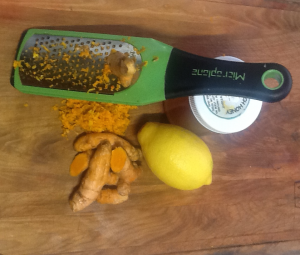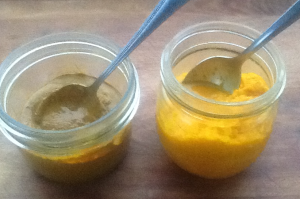Award Winning Author
Face Reading with Before & After Photos
Fermented Turmeric Tea
Medicine from Scratch
To enhance turmeric’s medicinal wallop, ferment it. In five minutes of your time (plus two days to ferment), you can create a base for a month’s supply of tasty and healing fermented turmeric tea.

Best known for its characteristic bright orange-yellow color and as a signature ingredient in curry, turmeric is the small rhizome (root) of a ginger relative. It has a musky aroma and a flavor that is both slightly astringent and bitter. The active ingredient in turmeric, curcumin, quells inflammation, supports digestion, deactivates carcinogens and prevents the release of histamines in the stomach, which counteracts food allergies. Turmeric also has antiseptic, antifungal and antibacterial properties.
Studies show that turmeric isn’t always easily absorbed and that people with compromised health aren’t able to fully utilize its active ingredients (curcumin and other curcuminoids). So here’s the great news: fermenting turmeric makes it easier for you to assimilate its medicinal properties. A study published in the International Journal of Food Science and Technology found that the antioxidant power of turmeric increases when it is fermented. Fermentation not only concentrates the curcuminoids but also mitigates its bitter flavor.
You can ferment either fresh or dried turmeric to make a turmeric concentrate (pictured below) that can be stirred into tea. Dried turmeric, which has been cooked and cured, has a milder flavor and aroma than fresh. (Other ways I enjoy turmeric fresh are shredded and added to sauerkraut, kimchi and beet kvass. Here’s a great turmeric-kraut recipe for Masala Kraut from Leda Scheintaub.)
Fresh turmeric is pricy, but a little goes a long way, and it is becoming increasingly available in markets. Look for rhizomes that are crisp and evenly colored; at home, they will hold for several weeks in the refrigerator. When using dried turmeric, purchase organic turmeric from a reputable source, as nonorganic turmeric may be adulterated.
Fermented Turmeric Tea Base

Makes about 2/3 cup (or ½ cup when made with ground turmeric)
4 ounces fresh turmeric or 1/3 cup ground turmeric
2 tablespoons raw honey
2 tablespoons freshly squeezed lemon juice
1/2 teaspoon lemon zest
1 ounce fresh ginger, grated (optional)
If using fresh turmeric, finely grate it (there’s no need to remove its soft skin). Place the fresh or dried turmeric in a pint jar. Add the honey, lemon juice, lemon zest and ginger, if using, and stir. Note: Initially the honey will not easily mix in, but in an hour or so it readily softens and dissolves on its own. Cover and let rest for a few hours. Stir to blend the ingredients and taste just a little to get a sense of its intense, pre-fermented flavor.
Cover loosely and leave on the counter for 48 hours to ferment. When ready, the flavors will be tangy and bitter; the fresh turmeric tea base will also be lively and sprightly. The consistency of the fresh will be like marmalade and the dried will be like peanut butter. Refrigerated, the base will hold for several months.
To make a tea or a tonic from the fresh turmeric base, place a rounded teaspoon into a tea ball or in a strainer and steep for several minutes. If using the base made from dried turmeric, stir a scant teaspoon into hot water or a tea of your choice and drink. By using hot, rather than boiling water, the living enzymes will remain vital.
I also enjoy a dollop of the fresh base straight from the jar; it has a punch and tastes so vital. The odds are you’ll find a number of ways to use fermented turmeric such as adding it to a salad dressing or smoothie.
To learn more about the healing powers of turmeric, I recommend Turmeric for Health, a web page dedicated only to the rhizome.
Thanks to my awesome physical therapist, Mary Gorman, for this recipe idea. Mary favors using Meyer lemons in her base.


I am hearing adding black pepper increases the absorption. Should I add some to the fermented turmeric recipe?
Sure, if you so wish and enjoy the flavor add the pepper. For more details on the energetic differences between black and white pepper, see my New Whole Foods Encyclopedia.
Hi, I’m trying out making fermented turmeric. I’ve put all the ingredients together, but it’s still very dry and not mixed well. Should I add more lemon juice or honey? When first mixed should it be a paste?
It sounds like you’re using the dried turmeric which, initially, is a dry paste. If necessary, add more lemon juice. As the blog suggests: Note: Initially the honey will not easily mix in, but in an hour or so it readily softens and dissolves on its own.
Could ground turmeric be added to homemade kombucha for flavoring? I am attempting to home brew kombucha and would also like to add more turmeric to our diets.
It is a strong flavor, but the fermenting would help take the edge off. Give it a try and let us know.
Rebecca, I wasn’t sure where to post this question about fermenting, but not related to the above tea recipe. Hope this is okay.
I am making a huge vat of hummus as we speak.
I had the hopes of being able to puree a small amount of my spare Kombucha mothers along with the hummus….for one, to not see these go to waste, and more importantly, I was considering fermenting the hummus for a day or so. I just can’t find any recipes that use a kombucha scoby as a starter for fermented hummus! Does this sound like a good plan or terrible! Any advice would be so appreciated.
Thanks!
I’d scrap it! Beans turn bad very quickly.
If someone has gallstones and doesn’t know and consumes turmeric, what dangers are there to using turmeric?
The good news is that herbs like turmeric–in comparison to drugs–are gentle medicinals and in moderate use, can be consumed safely. Using turmeric in high doses may be problematic for some people. If you’re concerned that you have gallstones, I invite you to do a thorough web search on turmeric’s contraindications.
Turmeric is not water soluble so needs to be consumed with some form of oil or fat otherwise it will just go through the system with little effect. Freshly cracked black pepper will increase the effect of the curcumin content as well. Better to use powdered Turmeric rather than fresh for ailments or pain as it contains far more curcumin. Turmeric has around 300 synergistic ingredients, some, like curcumin have been studied quite extensively, so curcumin isn’t the only beneficial substance in this incredible spice. The benefits of Turmeric are vast and the warnings about dosage usually prove to be about supplements, you can consume real Turmeric quite safely unless you have an issue like gallstones. Turmeric has been used with incredible success with both humans and animals. Check out Turmeric user group on FB for everything you could possibly want to know.
Heather – I went to the FB site but couldn’t figure out how to join. Several places show a locked lock. Also it said to read the pinned info at top of page – I didn’t find that either. HELP.
Sally….my mistake for not checking the FB link.
You’ll find the TurmericForHealth.com link in my blog is active and is loaded with informatino.
Sally – Did you get there in the end? They have a website also called Turmeric life.
Cheers 🙂